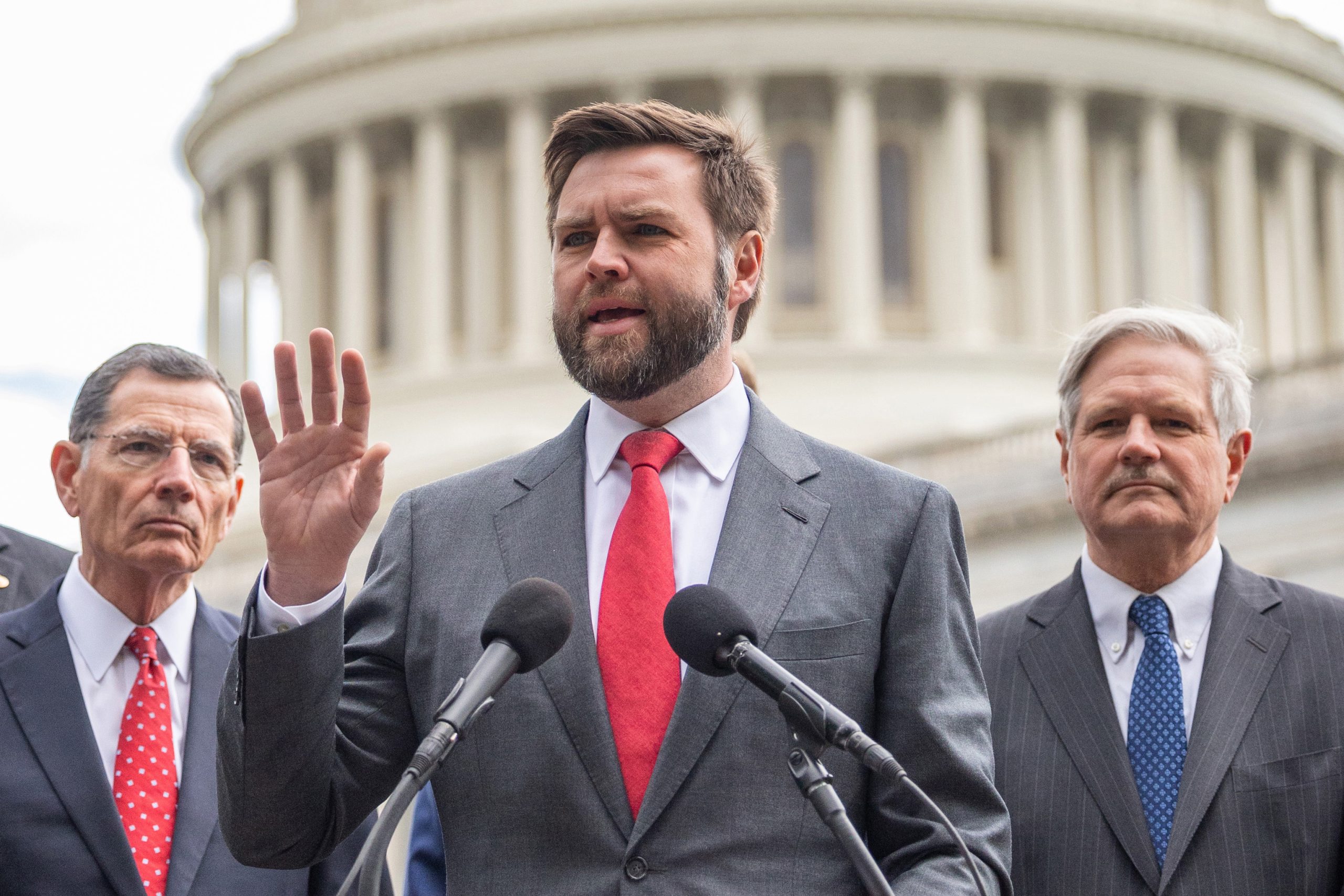Senator Vance: “This town very well may have been poisoned to facilitate the rapid movement of freight”
WASHINGTON, D.C. – Today, under questioning from Senator JD Vance (R-OH), National Transportation Safety Board (NTSB) Chair Jennifer Homendy revealed that the chemical explosion in East Palestine, Ohio was not necessary and that the chemical experts who advised against the “vent and burn” were ignored.
Two days after a Norfolk Southern train derailed in East Palestine, a vent and burn was conducted on five vinyl chloride monomer (VCM) tank cars. Findings from the NTSB reveal the recommendation of Norfolk Southern’s contractors to conduct the burn lacked sufficient scientific basis, disregarded available temperature data, and contradicted expert feedback. Findings also reveal local leaders, who made the decision to conduct the burn, were not made aware of critical facts which could have led to a different course of action.
Watch Senator Vance’s exchange with Chair Homendy here and read a transcript below.
Senator Vance: Thank you, Madam Chair, and thanks, Chair Homendy, for being here and for all your work. I know a lot of folks have focused on the Alaska Airlines questions. I want to focus on the train derailment in East Palestine, and specifically, Madam Chair, I want to focus on this question of whether the controlled burn was actually necessary in East Palestine. To sort of recap for folks, the mushroom cloud, the chemical mushroom cloud that captured headlines across the country was the result of a controlled burn. What those of us who are sort of focused on this issue were told is that if you hadn’t done the controlled burn, there would have been an uncontrolled explosion because the situation on the ground was just incredibly chaotic and dynamic. You had to do the controlled burn to prevent the uncontrolled explosion.
And your team has done a very good job. I commend you and your team on actually looking into whether this was necessary and you’ll forgive me for requesting brief answers to questions because I have a lot of them, and I just want to walk through in detail what you folks have found. This is based on public reporting that me and my team have gone through.
So, February 3rd, 2023, derailment of the train. Is it true that Norfolk Southern’s contractors monitored temperatures on one of the chemical tank cars from the afternoon of February 5th into the afternoon of February 6th, which is when the controlled burn happened, and communicated their initial readings to Oxy Vinyls, the shippers in charge of the vinyl chloride cars?
Chair Homendy: That’s accurate, Senator.
Senator Vance: Is it true that these readings indicated an initial temperature of 135 degrees Fahrenheit at 4 PM on February 5th, which eventually declined to 126 degrees Fahrenheit at 9:30 AM on February 6th, at which point it stabilized?
Chair Homendy: That’s correct, Senator. It was stabilized well, well before the vent and burn. Many hours before.
Senator Vance: So declining temperatures, you would think, and stabilized temperatures, are consistent not with something that needs to be exploded, but with something that can be dealt with in a slightly less catastrophic way, at least that’s my read on it. But, is it true that the chemical shipper, Oxy Vinyls, concluded that the reported and stabilized tank car temperatures were too low for a runaway chemical reaction, meaning, the sort of thing that would lead to an uncontrolled explosion?
Chair Homendy: That’s correct. They had testified that polymerization was not occurring. In order for polymerization to occur, which was Norfolk Southern and their contractors’ justification for the vent and burn, you would have to have rapidly increasing temperatures and some sort of infusion of oxygen, neither of which occurred.
Senator Vance: Right, and just to be clear, you would need both of those things? It’s not an either or, you need both of them to precipitate polymerization, which would lead to an uncontrolled situation?
Chair Homendy: Correct.
Senator Vance: Is it true that Norfolk Southern’s contractors testified to the NTSB that they were not certain that chemical reaction was occurring in the derailed vinyl chloride tank car?
Chair Homendy: They testified to that, yes, sir.
Senator Vance: Is it correct that the chemical shippers testified that there was no free radical agent or sufficient heat trajectory to justify Norfolk Southern contractors’ assessment that a chemical reaction was occurring?
Chair Homendy: That’s correct.
Senator Vance: So, from this assessment, is it your understanding Norfolk Southern’s contractors lacked scientific basis to support their conclusion that polymerization was occurring in the derailed VCM tank cars?
Chair Homendy: Yes. In fact, they were informed by Oxy Vinyls of the information that should have been taken by the contractors in their decision making. But yes, they did not have that. They lacked the scientific background to address that.
Senator Vance: So let me just go to one final question here. We combine all these facts together, your reporting thus far concludes that Norfolk Southern’s contractors’ recommendation to conduct a controlled burn lacks sufficient scientific basis, disregarded available temperature data and contradicted expert feedback from the shipping firm on site.
Now, this was all told to the decision makers on the ground that they had to make a decision in less than 13 minutes to blow up all five of these toxic chemical cars without any other voices being included to offer a contrary opinion, is that right?
Chair Homendy: That’s correct.
Senator Vance: So, again, I appreciate your work on this, but just to sort of summarize, this is an extraordinary finding. We were told, effectively, that there were two bad options, the controlled burn or the uncontrolled explosion. And it seems, based on the data that we have, that there was not a ton of reason to do the [controlled] burn. And that, of course, is what spread toxic chemicals all over this community and the surrounding region. It’s really an extraordinary finding, it goes to highlight the importance of your work.
I also have to note that residents on the ground talk about the fact that immediately after the [controlled] burn, they moved the tank cars and train traffic was moving through their town and moving through their community. I won’t ask you to speak to motivations here, but when you have an unnecessary, [controlled] burn that poisoned a lot of people, that then led to rapid transit of train traffic, a lot of people, including me, are wondering, did they do this not because it was necessary, but because it allowed them to move traffic and freight more quickly?
If so, that is an extraordinary thing that I think requires a lot of further work from this committee and from others.
Chair Homendy: May I add something to that, Senator? It’s even, you know, I would say, the factual information in our docket shows that Oxy Vinyls was on scene and providing information to Norfolk Southern and their contractors on [January] fourth, fifth and sixth. They informed them that polymerization, they believed polymerization was not occurring, and there was no justification to do a vent and burn. Rightfully, Norfolk Southern’s contractors had ruled out hot tapping and transloading because it would have been a potential safety issue for their employees, but there was another option: let it cool down.
It was cooling down. We know for a fact that when that pressure relief device went off, that it had to have been above 185 degrees. Later, much later, over the course of 22 hours, that tank car was cooling. Not to mention the other four tank cars that were only between 64 and 69 degrees. So Oxy Vinyls was on scene providing information to Norfolk Southern’s contractor who was in the room when the decision was made, and when advice was given to the governor of Ohio, to the incident commander, they were not given full information because no one was told Oxy Vinyls was on scene. They were left out of the room. The incident commander didn’t even know they existed. Neither did the governor. So they were provided incomplete information to make a decision.
Senator Vance: My line of questioning, I just want to be clear here, is not a criticism of the incident commander or of the governor. I think it’s a criticism of the people on the ground who provided inadequate information, and provided inadequate information, I think, to the great detriment of the community on the ground. This is extraordinary work by your team, but this is a really, really troubling set of circumstances.
This town very well may have been poisoned to facilitate the rapid movement of freight, or at the very least, it was poisoned for reasons that we can’t identify. That should really concern every single person on this committee.
For Background:
- In response to the derailment in East Palestine, Senator Vance introduced the bipartisan Railway Safety Act, which would enact commonsense safety standards across the nation’s largest railroads.
- The Railway Safety Act passed the Senate Commerce Committee in May of 2023 with bipartisan support and is now awaiting a vote on the Senate floor.
- President Donald Trump has endorsed the legislation, as has President Joe Biden, Ohio Governor Mike DeWine, and East Palestine Mayor Trent Conaway.
- The Railway Safety Act has been endorsed by conservative organizations such as the Center for Renewing America, American Compass, and the American Principles Project.
###


